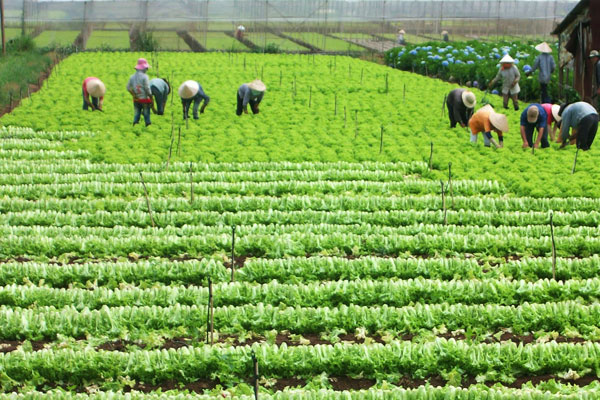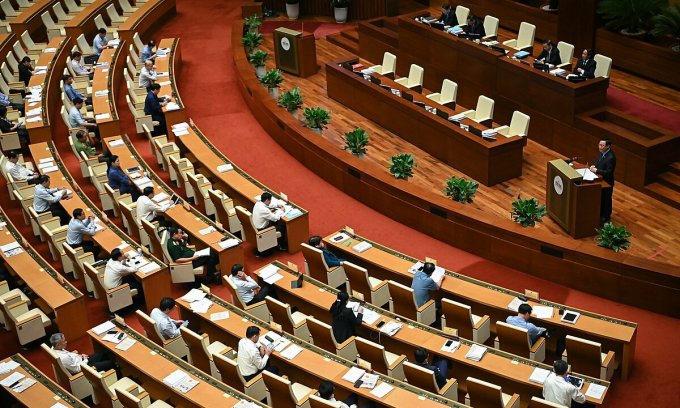What is the current state of land use in Vietnam?

Land is a precious human resource. However, at present, the issue of planning and land use has not been given due attention. There are projects and projects with loose planning and management that cause many serious consequences. So about the matter “What is the current state of land use in Vietnam?” Let’s find out with LSX in the article below.
Legal grounds
- Land Law 2013
What is the current state of land use in Vietnam?
The task of monitoring and assessing the situation of land management and use is an innovative content of the 2013 Land Law in order to properly assess the situation of law enforcement implementation and state management of land. , land use efficiency and the impact of land policies and laws on the economy, society and environment in each locality and nationwide.
According to the 2013 Land Law, a monitoring and evaluation system for land use and management is part of a land information system; uniformly established from the central to local levels and published on the national information network in accordance with law. The monitoring and evaluation system for land management and use must reflect the scale, quality and efficiency of land management and use; impacts of policies and laws on land; transparency and people’s participation in the process of land management and use through quantitative and qualitative indicators.
The 2013 Land Law stipulates that the Ministry of Natural Resources and Environment is responsible for:
– Design and build a monitoring and evaluation system for land management and use; manage, organize and operate the system of monitoring and evaluation of land management and use at the central level; guide the management and operation of the monitoring and evaluation system for land use and management in the locality.
– Direct and guide the organization and implementation of the annual assessment of land management and use and the impact of policies and laws on land.
– Prepare periodic reports and irregular reports on land management and use and the impact of policies and laws on land.
– Promulgate criteria and evaluation process for land management and use and the impact of policies and laws on land; forms, reporting forms and reporting responsibilities of the system of natural resources and environment agencies.
Provincial-level People’s Committees are responsible for directing the construction and operation of a monitoring and evaluation system for local land use and management.
In order to implement the tasks prescribed by the Land Law for land use management assessment, from 2015-2017, the Ministry of Natural Resources and Environment and the General Department of Land Management directly implemented Some contents and promulgation of documents directing the provinces are as follows:
– The Ministry of Natural Resources and Environment issued Document No. 3215/BTNMT-TCQLĐD dated August 5, 2015 on strengthening inspection, supervision and building a monitoring and evaluation system for management activities, land use; The General Department of Land Management has issued Official Letter No. 1660/TCQLĐD-CKSQLSDĐD dated November 9, 2015 and Official Letter No. 1678/TCQLĐD- CKSQLSDĐD dated August 31, 2016 guiding the preparation of monitoring and evaluation reports and report on the situation of land management and use and the impact of land policies and laws on the economy, society and environment. Therefore, from 2015 up to now, localities have implemented and collected assessments according to the form system according to the guidance of the General Department of Land Management to develop reports on assessment of the management and annual land use.
However, the implementation has not brought high efficiency, in 20-15, 39 provinces and cities submitted reports, in 2016 there were 47 provinces, however, only 30 provinces submitted reports on time, 33 provinces submitted reports. In accordance with regulations, 27 provinces have relatively satisfactory report quality (full data and tables as prescribed). In general, localities have not paid attention to the development of evaluation reports, have not assigned responsibility to a specific specialized unit to carry out monitoring and evaluation, so the monitoring and synthesis of data has not been successful sticky rice.
In addition, the General Department of Land Management has inspected the implementation of the 2013 Land Law in 22 provinces: Yen Bai, Hai Duong, Nam Dinh, Bac Can, Nghe An, Thua Thien Hue, Dong Thap, An Giang, Tuyen Quang, Cao Bang, Ha Nam, Quang Tri, Ben Tre, Long An, Tien Giang, Binh Thuan, Ha Giang, Son La, Binh Dinh, Phu Yen, Binh Duong and Lao Cai. The contents and criteria for examination and evaluation include: The promulgation of legal documents, propaganda, dissemination and education of the law on land; the formulation, adjustment, management and implementation of master plans and plans on land use; the allocation of land, lease of land, change of land use purpose; land recovery, compensation, support and resettlement upon land recovery; the measurement and registration of land, grant of certificates of land use rights, ownership of houses and other land-attached assets; the financial management of land and land prices, the inspection, examination, supervision, monitoring and evaluation of the observance of the provisions of the law on land.
Thus, the monitoring and assessment of land management and use in accordance with the provisions of the Land Law 2013 in the localities has been carried out, however, because there is currently no specific content and process to guide so each locality does it in its own way, it has not yet become a regular routine every year; the evaluation content is incomplete and not deep; assessment quality is still limited, not close to reality, still subjective and qualitative, but lack of evidencing information and data; Therefore, it is difficult to synthesize nationwide. In the year 2015-2016, a number of localities have sent official letters requesting the Ministry to provide specific instructions on the development of indicators and order of assessment of land management according to the requirements of the 2013 Land Law.
The main reason is that at present, there has not been a unified monitoring and evaluation system and guidelines for implementation nationwide; The assessment of the situation of land management and use in the locality has not been paid much attention, the apparatus for implementation has not been organized, the implementation plan has not been developed, the unified criteria has not been established, and the content has not yet been established. full assessment content; therefore, there have not been results of assessment that are close to each locality and consistent across the country; in addition, the system of specialized inspection and inspection agencies on land is still unstable in terms of organization; force is still thin; The capacity and professional qualifications of a part of staff engaged in inspection and examination are still weak, failing to meet the requirements of inspection and examination tasks, detecting and handling violations in management. management and use of land; the contingent of cadastral officers at commune level has not yet been stable; equipment for detecting and handling violations is lacking; regulations on penalties for violations are still low, and it is difficult to determine the level of administrative penalties according to current regulations.
Some solutions to strengthen the assessment of land management and use at all levels
In order to fulfill the development target and orientation by 2030, which is to build a modern land management system, reaching the level of developed countries in the region, the assessment of land use and management of localities since the 2013 Land Law is very important; help state management agencies assess the overview of land management and use in the past time, thereby planning management policies in the coming time, to contribute to improving the effectiveness and efficiency of housing management. Regarding land, the land management sector should pay attention to implementing the following main solutions:
(1) Completing the system of policies and laws on land on the principle of continuing to maintain the regime of land ownership by the entire people; creating a favorable legal environment for land to participate in the real estate market; effectively exploit the potential of land; ensure democracy, social justice and sustainable development.
(2) Completing the system of investigation and assessment of land resources, ensuring the provision of sufficient information and documents on the quantity, quality, potential and environment of land for policy making and decision-making. implement decisions of state agencies in the field of land management and use.
(3) Building a modern land registration system with basic processes and procedures automated by digital technology; uniformly deploying nationwide the system of digital cadastral dossiers which are regularly and timely adjusted for fluctuations; in which, completing the construction and operation of a system of digital cadastral records in a number of provinces and cities.
(4) Building an automated land inventory and statistics system based on a system of digital cadastral records that is updated regularly and fully, ensuring the provision of statistics and inventory. Quickly and accurately.
(5) Completing the system of land use planning and planning as a tool for state management of land, ensuring a reasonable allocation of land resources, effective management and use of land, and speeding up the process of restructuring land use in accordance with the transformation of labor structure and economic structure in the process of industrialization – modernization of the country.
(6) Completing the system of financial and land economic tools to regulate land relations and manage the real estate market. In which, the land pricing system ensures that the land pricing requirements are met for different purposes in the management, use and transactions of land use rights; The land fund development system is perfected in terms of professional processes, mechanisms and reasonable financial potential, meeting the demand for land fund creation for socio-economic development.
(7) Strengthen the effectiveness and efficiency of inspection, examination and control in order to bring the management and use of land in accordance with the law.
(8) Completing the construction of the land information system into a part of the National Data System.
(9) Consolidate the system of organizational apparatus; improve the capacity of cadres in the land management sector synchronously from the central to local levels, ensure the unified state management of land nationwide, have clear assignment and decentralization, and operate effective and efficient action. Development of technical infrastructure, investment in equipment, application of scientific advances
A few recommendations for land management and use
Statistics show that, in some provinces and cities, there is a significant decrease in agricultural land area, such as the Red River Delta, which decreased by 32,000 hectares after only 5 years (2005-2010). Along with that is an increase in the size of land used for non-agricultural purposes. This decline is due to the fact that a part of agricultural land has been converted to use for non-agricultural purposes and other purposes, such as: construction of industrial works, irrigation works, transportation. , housing, social infrastructure works… Meanwhile, the agricultural land fund is no longer capable of expanding much. This will be a challenge for managers, land planners and policy makers.
A development trend in the future is the tendency to sharply increase the demand for land for non-agricultural purposes, especially the pressure to increase demand for specialized land for economic development. socio-economic. When the unused land area has been fully utilized, the land fund for non-agricultural, production and business purposes can only be partially transferred from the agricultural land fund. This will significantly affect the production output in the agricultural sector as well as the farmers who had the right to use this land fund before, changing the labor structure in these regions and localities.
Therefore, land use planning needs to have comprehensive impact assessments on the benefits and costs of converting land use purposes into non-agricultural purposes, especially in regions and localities. there is a sharp decline in agricultural production land fund, so that it is possible to propose effective land use planning in the region and locality.
Services of LSX
Prestigious professional services: Firstly, the team of consultants and consultants for many years in the field of civil status, and customer support.
On-time: Certainly, with the motto “Get your lawyer right at your fingertips”, we ensure the service always performs on time. The rights and interests of customers always come first.
Cost: Besides, LSX’s service costs are highly competitive; depending on the nature of the particular case. So, we want our guests to have the best possible service experience. Therefore, costs which guaranteed to be the most suitable and economical for customers.
Confidentiality of client information: Finally, all brand information of client LSX will be 100% confidential.
Please contact us immediately if you have any questions about “What is the current state of land use in Vietnam?”
Contact LSX
Finally, hope this article is useful for you to answer the question about “What is the current state of land use in Vietnam?” If you need any further information, please contact LSX Law firm: at +84846175333 or Email: [email protected]
Please see more
- Procedure of land acquisition for project implementation in Vietnam
- Sequence of recovering encroached land in Vietnam
- Land valuation income method in Vietnam
Frequently asked questions
The monitoring and evaluation of land management and use in accordance with the provisions of the Land Law 2013 in localities has been carried out, however, because there are currently no specific guiding contents and procedures, each locality should method of implementation in a particular way, which has not yet become a regular annual routine; the evaluation content is incomplete and not deep; assessment quality is still limited, not close to reality, still subjective and qualitative, but lack of evidencing information and data; Therefore, it is difficult to synthesize nationwide. In the year 2015-2016, a number of localities have sent official letters requesting the Ministry to provide specific instructions on the development of indicators and order of assessment of land management according to the requirements of the 2013 Land Law
The General Department of Land Management has inspected the implementation of the 2013 Land Law in 22 provinces: Yen Bai, Hai Duong, Nam Dinh, Bac Can, Nghe An, Thua Thien Hue, Dong Thap, An Giang, Tuyen Quang, Cao Bang, Ha Nam, Quang Tri, Ben Tre, Long An, Tien Giang, Binh Thuan, Ha Giang, Son La, Binh Dinh, Phu Yen, Binh Duong and Lao Cai. The contents and criteria for examination and evaluation include: The promulgation of legal documents, propaganda, dissemination and education of the law on land; the formulation, adjustment, management and implementation of master plans and plans on land use; the allocation of land, lease of land, change of land use purpose; land recovery, compensation, support and resettlement upon land recovery; the measurement and registration of land, grant of certificates of land use rights, ownership of houses and other land-attached assets; the financial management of land and land prices, the inspection, examination, supervision, monitoring and evaluation of the observance of the provisions of the law on land are still unreasonable.
The Ministry of Natural Resources and Environment is responsible for:
– Design and build a monitoring and evaluation system for land management and use; manage, organize and operate the system of monitoring and evaluation of land management and use at the central level; guide the management and operation of the monitoring and evaluation system for land use and management in the locality.
– Direct and guide the organization and implementation of the annual assessment of land management and use and the impact of policies and laws on land.
– Prepare periodic reports and irregular reports on land management and use and the impact of policies and laws on land.
– Promulgate criteria and evaluation process for land management and use and the impact of policies and laws on land; forms, reporting forms and reporting responsibilities of the system of natural resources and environment agencies.
Provincial-level People’s Committees are responsible for directing the construction and operation of a monitoring and evaluation system for local land use and management.
Conclusion: So the above is What is the current state of land use in Vietnam?. Hopefully with this article can help you in life, please always follow and read our good articles on the website: lsxlawfirm.com




